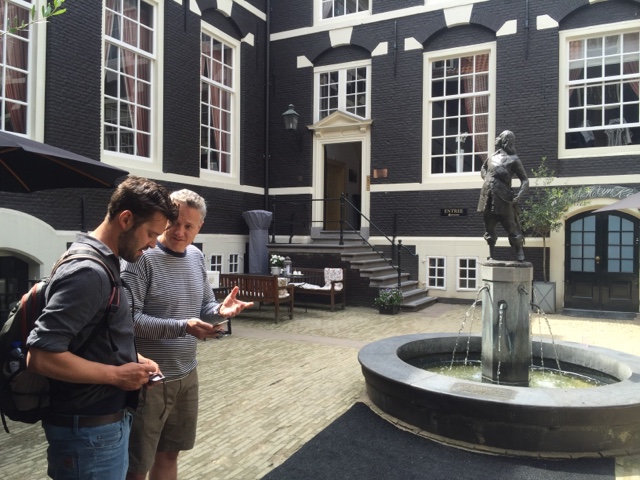DS celebrated his birthday solo in NYC this week. BUT, he flew in last weekend for a whirlwind of activities, not the least of which included our going-away party, Reese's (early) 7th birthday party, and some grab-and-go birthday moments of his own.
A private bike tour of Amsterdam has been on my bucket list for a while now, and I really hoped if I found the right tour guide, someone who understood we'd been here for three years and wanted to dive a little deeper, it could be a fun birthday present for DS. So, I gave it a shot.
Hello, "Hudson" River.
The statue is Peter Stuyvessant, governor of New York from 1647-1664 (until it was basically ceded to England). Unbelievably, he was the seventh Director-General of New Amsterdam, and he started his new job in 1647. Jeez.
And he was a pretty important dude in the early history of New York, working hard to expand the Dutch settlement beyond the tip of Manhattan Island. He is credited with "Wall Street,' which at the time was an actual wall to protect the city (and from where we get the now totally unrelated name of U.S. stock market), with the canal that became Broad Street, and with Broadway.
I've been wanting to explore examples of the Amsterdam School, an architectural style that emerged between 1910-1930 as a response to the blockish, "harsh" architecture that preceded it. The architects of this school focused on workers housing and government buildings, and the style is characterized by:
This is a must-see example of the Amsterdam School: Het Schip (The Ship). For the very reason that from a distance it looks like a ship, in addition to many ship-like details.
Always a bit of art deco in the Amsterdam School . . . check out the address numbers.
And he was a pretty important dude in the early history of New York, working hard to expand the Dutch settlement beyond the tip of Manhattan Island. He is credited with "Wall Street,' which at the time was an actual wall to protect the city (and from where we get the now totally unrelated name of U.S. stock market), with the canal that became Broad Street, and with Broadway.
I've been wanting to explore examples of the Amsterdam School, an architectural style that emerged between 1910-1930 as a response to the blockish, "harsh" architecture that preceded it. The architects of this school focused on workers housing and government buildings, and the style is characterized by:
"Buildings of the Amsterdam School are characterized by brick construction with complicated masonry with a rounded or organic appearance, relatively traditional massing, and the integration of an elaborate scheme of building elements inside and out: decorative masonry, art glass, wrought ironwork, spires or "ladder" windows (with horizontal bars), and integrated architectural sculpture. The aim was to create a total architectural experience, interior and exterior."
This is a must-see example of the Amsterdam School: Het Schip (The Ship). For the very reason that from a distance it looks like a ship, in addition to many ship-like details.
Always a bit of art deco in the Amsterdam School . . . check out the address numbers.
It was such an awesome day.
We capped it off with Dutch gin at one of the oldest "brown cafes" in Amsterdam, Cafe Papeneiland (Pope Island Cafe), which was a place of secret worship for Catholics when the Protestants pushed the Spanish out and took over the city. There's even a secret tunnel that supposedly went under the canal so people could get to clandestine places of worship (I could go on and on about all of the secret churches in Amsterdam). This bar is literally right out of the Golden Age.
While I'm at it, HAPPY FATHER'S DAY to our favorite guy. We love you. We miss you.
We capped it off with Dutch gin at one of the oldest "brown cafes" in Amsterdam, Cafe Papeneiland (Pope Island Cafe), which was a place of secret worship for Catholics when the Protestants pushed the Spanish out and took over the city. There's even a secret tunnel that supposedly went under the canal so people could get to clandestine places of worship (I could go on and on about all of the secret churches in Amsterdam). This bar is literally right out of the Golden Age.
While I'm at it, HAPPY FATHER'S DAY to our favorite guy. We love you. We miss you.









No comments:
Post a Comment